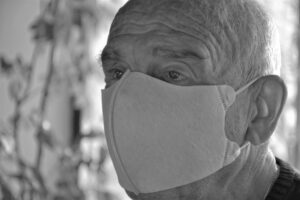Are people with Parkinson’s disease at risk of getting infected?
No, having Parkinson’s disease does not increase your risk of getting infected with COVID-19. It is direct contact with someone infected with this coronavirus that puts them at risk. Indeed, the majority of COVID-19 cases are attributable to person-to-person transmission, when the small respiratory droplets of the infected person enter the respiratory system of the uninfected person. These droplets can also enter through the eye. The projection of respiratory droplets can reach two meters.
There are other modes of transmission that are much less widespread, but applied all the same a risk. First, the airway, that is, the projection of droplets that can remain suspended in the air and travel greater distances. This is why interior contacts, especially if the ventilation is faulty, are riskier. Transmission through passive vectors such as a surface on which the virus could survive for a few hours to a few days is also possible. (Center for Disease Control and Prevention 2020)
Barrier gestures, such as distancing, wearing a mask and washing hands, are important to respect to limit the risk of contamination.
Does Parkinson’s disease increase the risk of developing a severe form of COVID-19?
The answer is not so clear. Few studies are currently available on the subject, the onset of the pandemic being still recent. So far, research shows that the biggest risk factor for developing a severe form is age. Moreover, according to a literature review (Zheng, Peng et al. 2020), men over 65 who smoke and people who have several health problems, that is to say comorbidities, such as hypertension, diabetes, cardiovascular disease and / or respiratory problems are the groups with the highest rate of severe disease and death from COVID-19.
It would therefore be the generally high age of people with Parkinson’s disease and the frequent presence of comorbidities that would make this population more vulnerable in the event of infection with COVID-19, and not Parkinson’s disease itself. (Papa, Brundin et al. 2020) A case study conducted among ten people living with Parkinson’s disease has shown that within this population, the mortality rate is higher among the oldest, those who have been living with the disease the longest and those who have advanced therapies (Antonini, Leta et al. 2020). Another study conducted on a larger sample showed that living with Parkinson’s disease increased the odds of death, regardless of age and sex, but this study did not take into account any comorbidities. (Zhang, Schultz et al. 2020) There are therefore too few studies published to date to draw any conclusions, other studies will undoubtedly clarify this information.
Are the symptoms of Parkinson’s disease worsening in a person who has contracted COVID-19?
Perhaps, but again, little research has been done on the subject. At this time, there does not appear to be a link between the exacerbation of symptoms of Parkinson’s disease and the presence of COVID-19. However, many people living with this neurological disorder infected with this coronavirus report worsening of their motor and non-motor symptoms. (Sulzer, Antonini et al. 2020) It is therefore still too early to determine whether or not COVID-19 is worsening Parkinson’s symptoms.
What are the consequences of the COVID-19 pandemic on people living with Parkinson’s disease?
There are several of them! The health measures imposed, although necessary to curb the spread of the virus, have significant deleterious effects. Interruption from usual activities and isolation can affect mood, make you more depressed and increase anxiety levels. In addition, the closure of community centers, fitness centers and other places of activity leads to a higher rate of sedentary lifestyle, with the serious consequences this can have on their physical and mental health. This is even more true in people with Parkinson’s disease.
A recent study indicates that the practice of physical activities in people with Parkinson’s disease has changed considerably since the start of the pandemic and that this has had effects on the symptoms reported. In fact, while half of people have reduced or even stopped exercising regularly, a third report that their symptoms worsen. According to this study, bradykinesia (slowness of movement) and feelings of stress were the motor and non-motor symptoms that worsened the most. (Song, Ahn et al. 2020)

How to reduce the impacts of the pandemic?
1. Maintain your usual appointments. Access to care may be more difficult in the current context of COVID-19, but it is important to continue to benefit from your usual care. Many specialists offer teleconsultations. Your pharmacists can also be good advisers for your medication. Do not hesitate to consult them if you have any questions.
2. Promote activities that make you feel good People with Parkinson’s disease are more prone to anxiety and the pandemic context can increase stress and thus some symptoms of the disease. It is therefore essential to reduce activities that cause anxiety and promote those that relax you. Whether it’s painting, cooking, singing, music or exercising, keep your body and mind busy!
3. Get regular physical activity. It is important to continue to exercise regularly because it is an integral part of the management of Parkinson’s disease. It has a vital role in the progression of the disease, but also helps in the reduction of stress and anxiety. If you can’t go out, you can take advantage of the video conferencing deals.
4. Be creative in maintaining your social contacts. Reduced social contact also has an impact on stress and anxiety. Although physical contact should be limited, it is important to maintain a bond with loved ones. Whether it is through the use of technologies such as Skype, Zoom, etc., the use of social networks or the use of crisis lines, several solutions are possible.
Sources:
Antonini, A., V. Leta, J. Teo and K. R. Chaudhuri (2020). « Outcome of Parkinson’s Disease Patients Affected by COVID-19. » Mov Disord 35(6): 905-908.
Center for Disease Contraol and Prevention. (2020). « How COVID-19 Spreads. » Retrieved 7 décembre, 2020, from https://www.cdc.gov/coronavirus/2019-ncov/prevent-getting-sick/how-covid-spreads.html.
Papa, S. M., P. Brundin, V. S. C. Fung, U. J. Kang, D. J. Burn, C. Colosimo, H. L. Chiang, R. N. Alcalay and C. Trenkwalder (2020). « Impact of the COVID-19 Pandemic on Parkinson’s Disease and Movement Disorders. » Mov Disord 35(5): 711-715.
Song, J., J. H. Ahn, I. Choi, J. K. Mun, J. W. Cho and J. Youn (2020). « The changes of exercise pattern and clinical symptoms in patients with Parkinson’s disease in the era of COVID-19 pandemic. » Parkinsonism Relat Disord 80: 148-151.
Sulzer, D., A. Antonini, V. Leta, A. Nordvig, R. J. Smeyne, J. E. Goldman, O. Al-Dalahmah, L. Zecca, A. Sette, L. Bubacco, O. Meucci, E. Moro, A. S. Harms, Y. Xu, S. Fahn and K. Ray Chaudhuri (2020). « COVID-19 and possible links with Parkinson’s disease and parkinsonism: from bench to bedside. » NPJ Parkinsons Dis 6: 18.
Zhang, Q., J. L. Schultz, G. M. Aldridge, J. E. Simmering and N. S. Narayanan (2020). « Coronavirus Disease 2019 Case Fatality and Parkinson’s Disease. » Mov Disord 35(11): 1914-1915.
Zheng, Z., F. Peng, B. Xu, J. Zhao, H. Liu, J. Peng, Q. Li, C. Jiang, Y. Zhou, S. Liu, C. Ye, P. Zhang, Y. Xing, H. Guo and W. Tang (2020). « Risk factors of critical & mortal COVID-19 cases: A systematic literature review and meta-analysis. » J Infect 81(2): e16-e25.







Comments